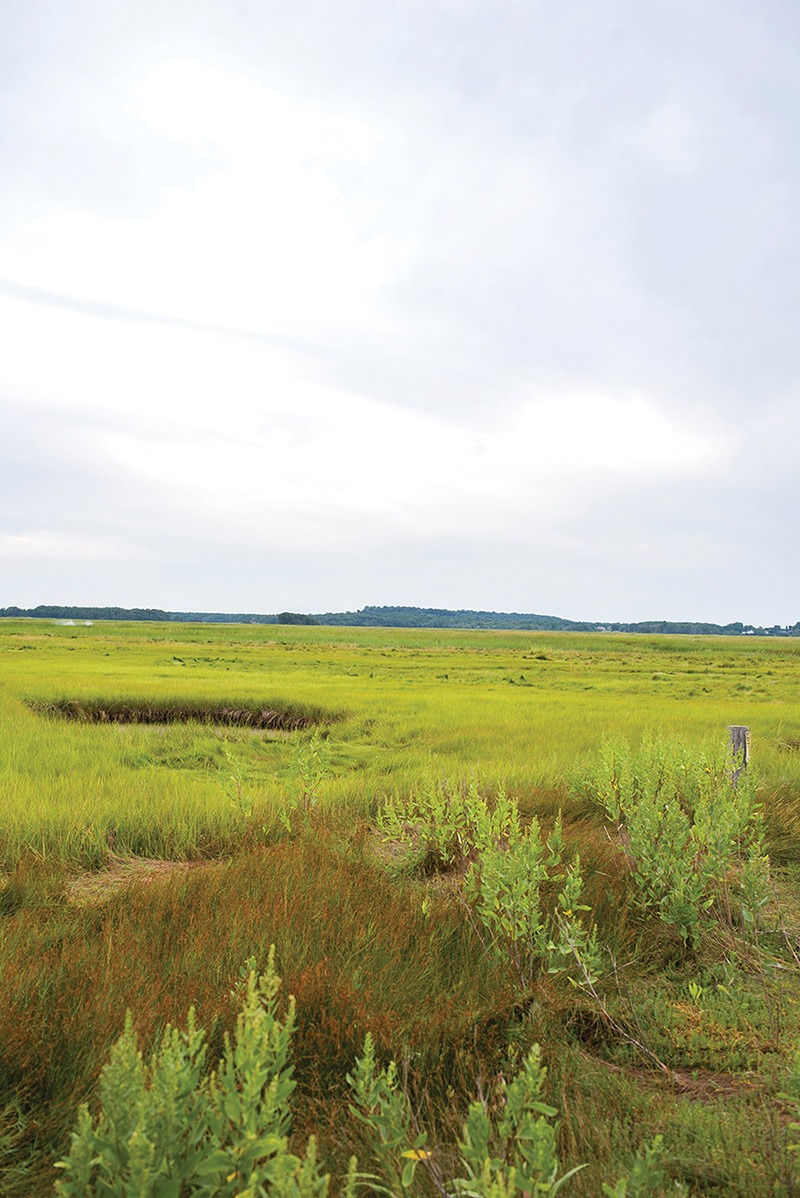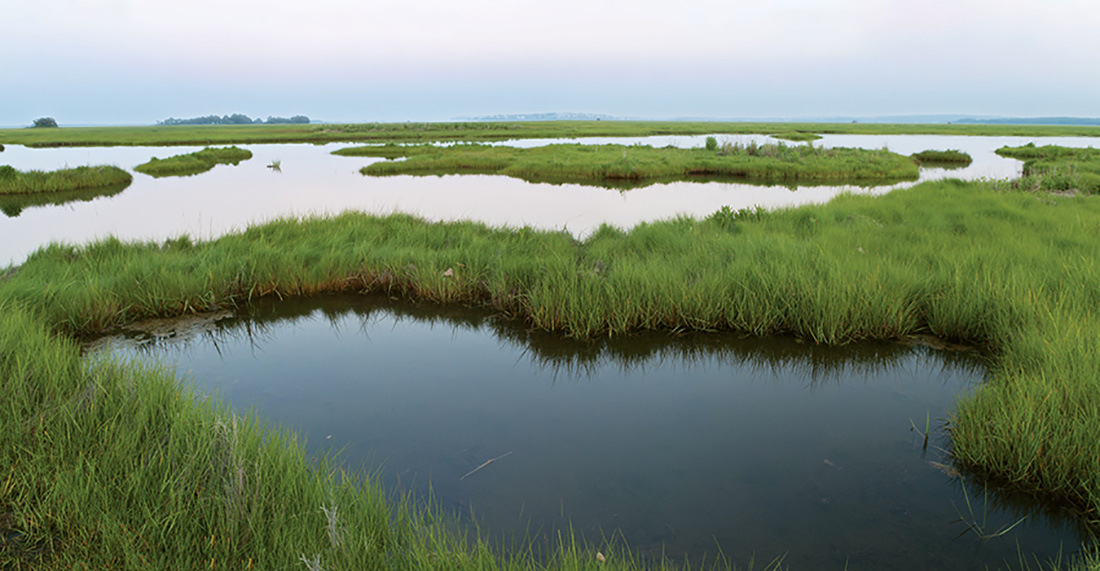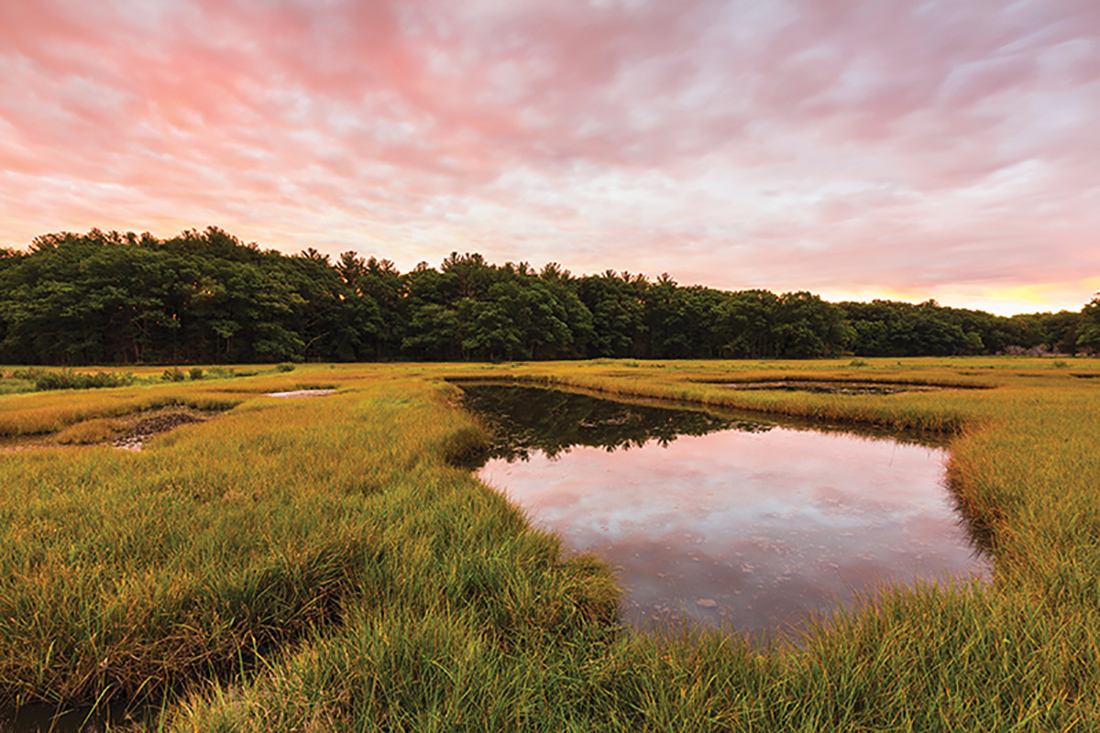On a clear summer day at Old Town Hill in Newbury, waves of green marsh grass bend in the breeze, tidal waters glint in the sun, and saltmarsh sparrows flitter away from rising tides. On even a casual viewing, it is clearly a charmed place.
What can’t be seen so easily, however, is the essential role Old Town Hill plays as part of the 25,000-acre Great Marsh. Stretching from western Gloucester to southern New Hampshire, the Great Marsh is the largest continuous salt marsh system in New England. It helps protect the coast from the impacts of rising sea levels, it is home to rare birds and tasty shellfish, it filters pollutants from groundwater, sequesters carbon from the air, and it offers almost endless opportunities for exploring by land and by water.

“The Great Marsh is the most wonderful place in the world no matter what season you’re out there,” says Geoffrey Walker, a Newbury selectman and decoy carver who has been working for decades to protect the marsh from invasive species. “It’s just a marvelous place.”
But the marsh is in trouble. Even as climate change drives rising sea levels, the marsh itself is sinking in many places, the result of agricultural decisions first made centuries ago. So over the next few years, the Trustees of Reservations, the land conservation nonprofit that owns Old Town Hill, is spearheading a project that aims to reverse this decline and help the marsh heal.
The present-day problem began in the 1600s, when the first white settlers to the area implemented agricultural practices they has used on the marshes back home in England. They dug long, straight ditches to speed the draining of the marsh at low tide, increasing the yield of salt marsh hay, which was used for bedding and fodder for livestock.
“Almost every acre of marsh was treated this way,” says Russell Hopping, lead ecologist for the Trustees. “From Canada down to the mid-Atlantic, they were just altered.”
Coastal farmers used this method of managing the wetlands until approximately the turn of the 20th century, when the proliferation of automobiles sharply reduced the need for both horses and oxen, and the hay used in their upkeep. As farmers abandoned their salt marsh fields, the ditches fell into disrepair.

Today, the damage has become so extensive that the natural drainage patterns of the marsh have been disrupted. The marsh is unable to drain efficiently, causing pools of standing water—Hopping calls them “mega-pools”—much larger than would occur naturally. This water kills marsh grass and dissolves biomass, causing the marsh to sink.
Healthy marshes provide an essential buffer against sea level rise, wind erosion, and storm surge. These benefits are lost when the marsh sinks.
The Trustees decided to take action on the problem after a 2017 study conducted in collaboration with Bourne-based environmental services firm The Woods Hole Group. The assessment pointed to salt marshes as some of the most vulnerable coastal habitats in Massachusetts.
The solution the organization found was a deceptively simple technique: Salt marsh hay will be mowed on-site, then loosely braided, layered into the ditches, and staked into place. The work is being done by hand, using nothing more technologically advanced than a walk-behind mower. Over time—and many tides—sediment will collect in the hay, filling the ditches in a way that closely approximates the natural processes of the marsh.
The marsh is already trying to restore its natural waterflow, says Geoff Wilson, principal of Northeast Wetlands Restoration, the environmental restoration company that is completing the work for the Trustees. This ditch-filling process will just give it a helping hand.
“The secret to this is that the salt hay is the same material that the peat is made of, roughly,” Wilson explains. “It becomes the same peat. It becomes healed.”

The process is a new one. It has been tested in pilot projects at two sites in the Parker River National Wildlife Refuge, on Plum Island, and in Rowley. These tests, which first began in 2009, have generated such positive results that the Trustees and Wilson are very optimistic about scaling up.
Restoration work began at Old Town Hill in April, and two additional sites, in Ipswich and Essex, are now in the permitting phase. The entire project is expected to take between three and five years, and will encompass some 350 acres of marshland, including Trustees properties and state-owned land. The price tag for completing work in each target area is expected to be about $270,000, with most of the money coming from government, corporate, and nonprofit grants.
Those involved in the project are excited about the chance to make such a difference for a wetland that is at once staggeringly beautiful, vitally important to the surrounding communities, and essential to the region’s ecology.
“It’s an iconic landscape,” Hopping says. “It’s one of the most pristine coastal ecosystems that we have.”

